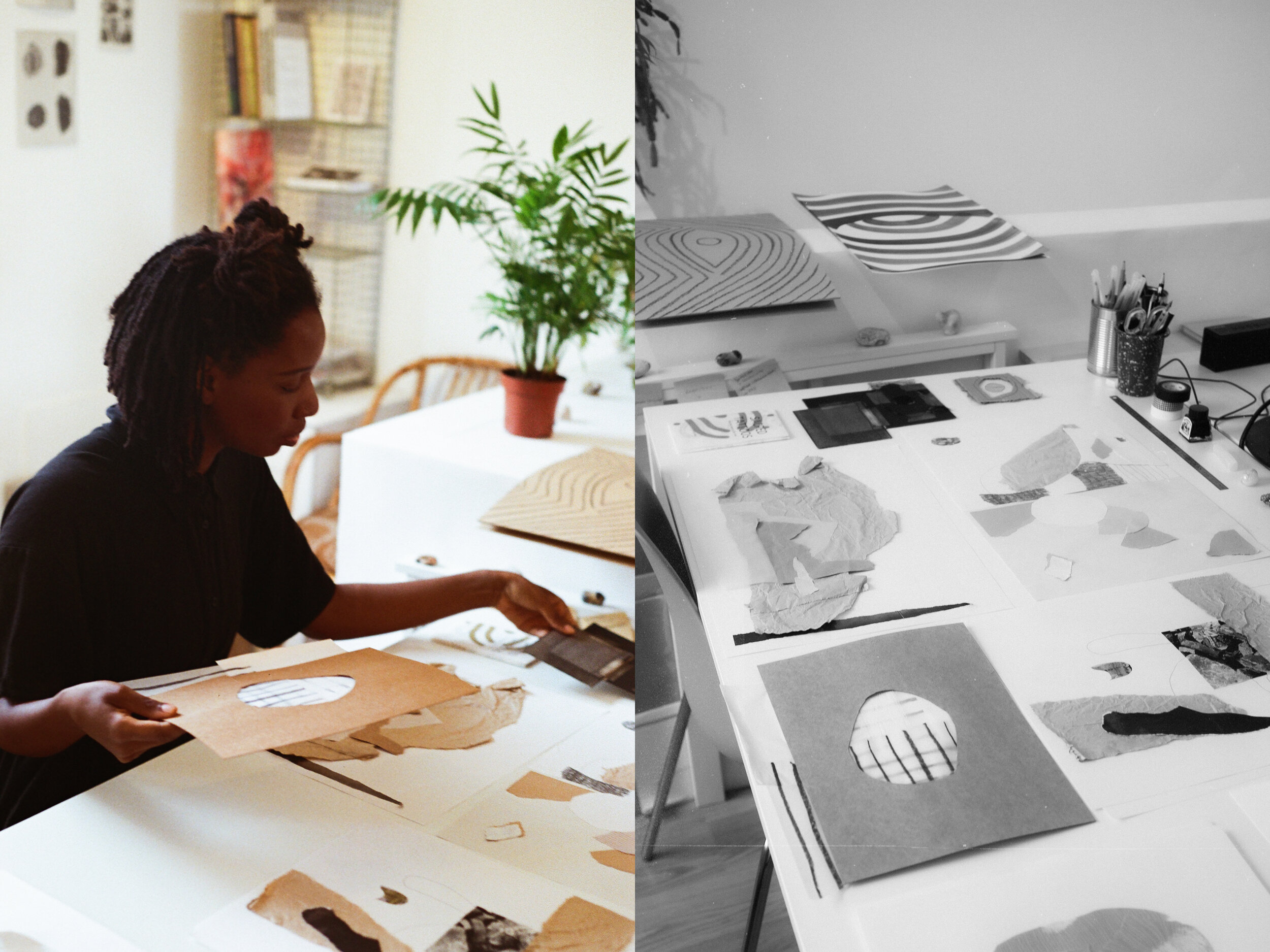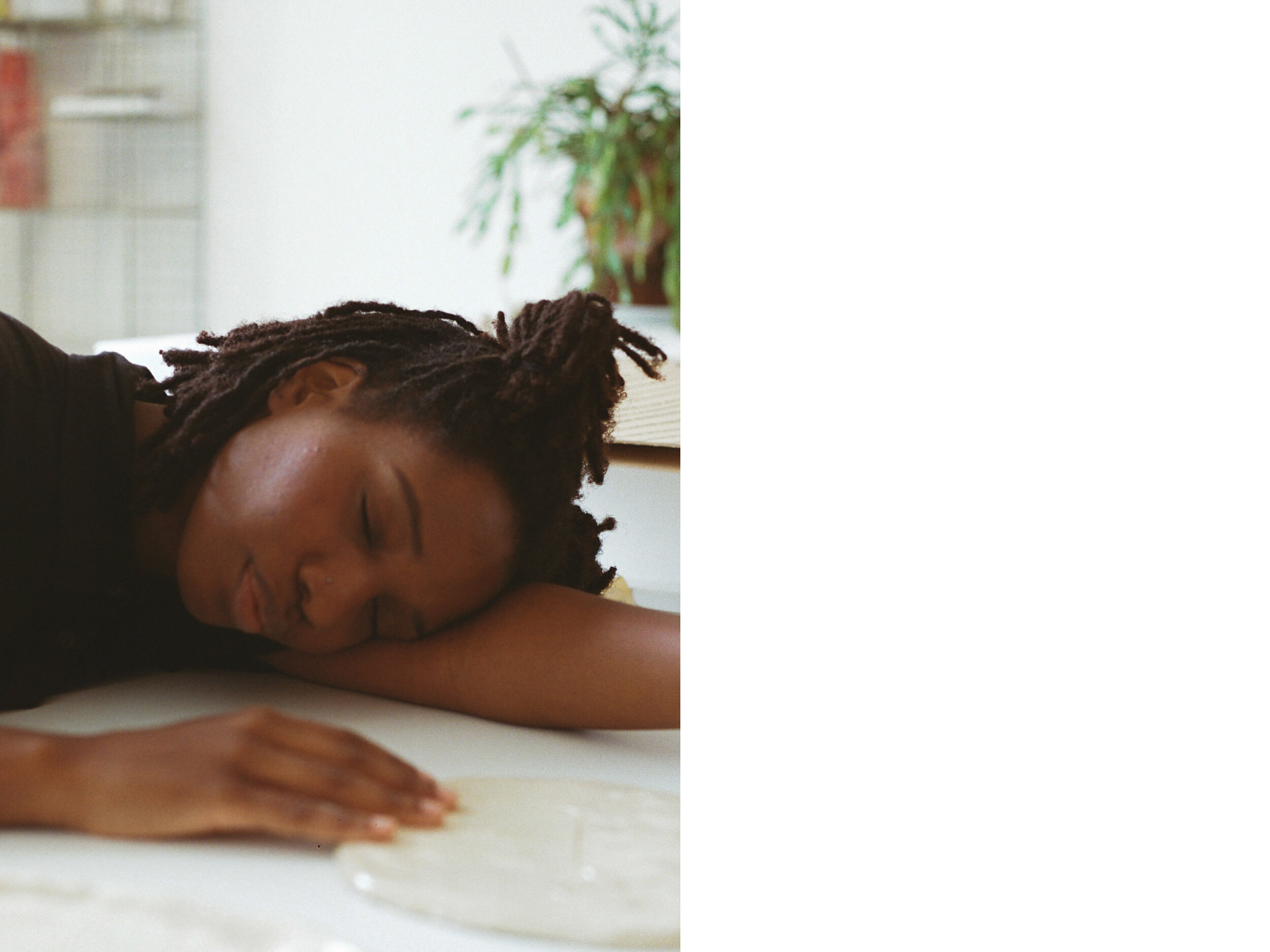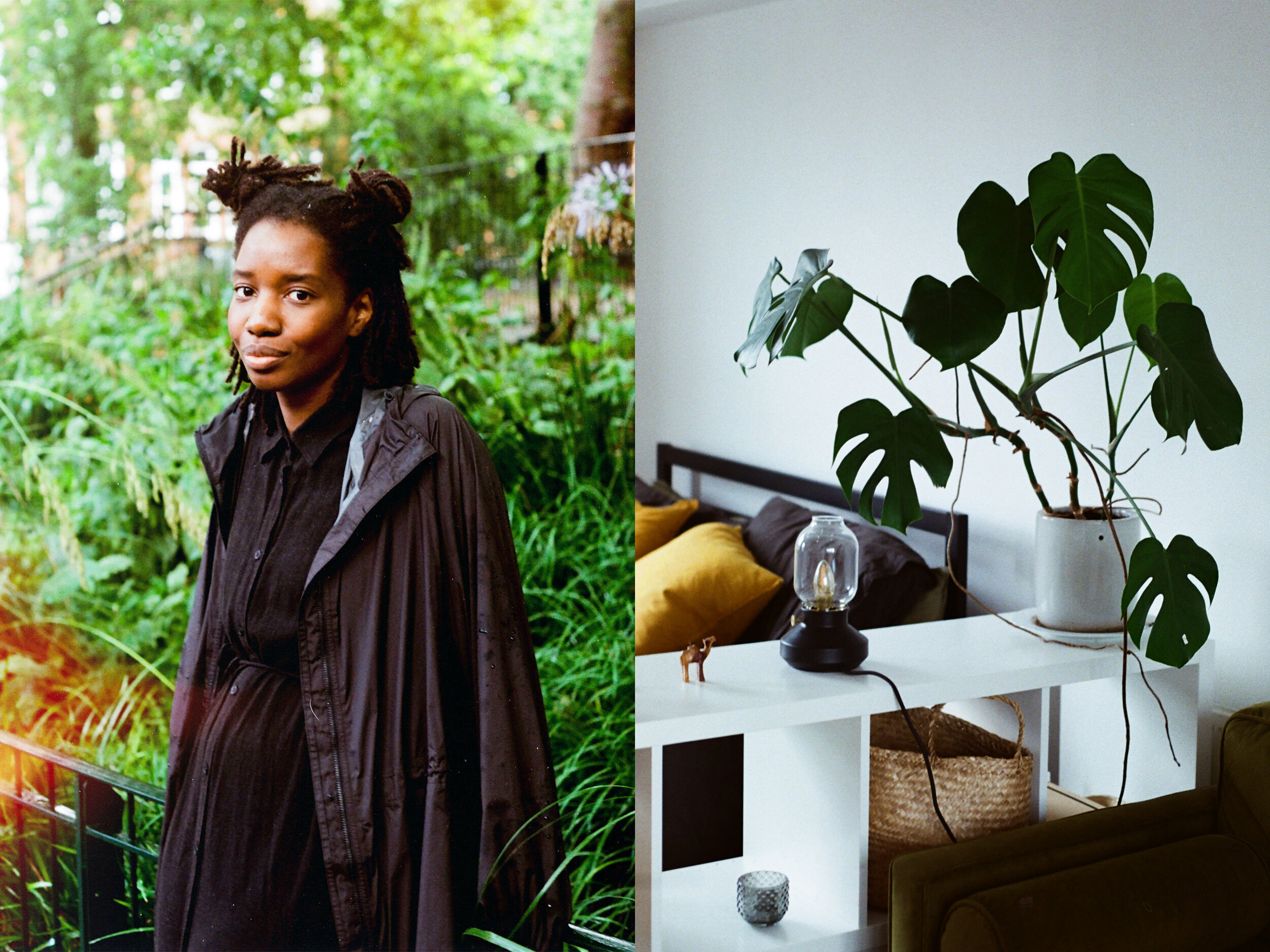Araki Koman: Finding Stillness Within
Featuring Araki Koman, Photography James Elliott, Creative Direction and Interview Nasreen Osman, Editor eucari
25歳から始めたアーティスト活動や静けさをもたらしたいという自身の作品の意図、“ミニマリズム”を求めて滞在した日本での気付き…。
ミニマルなイラストレーションで知られるロンドン在住のアーティスト、アラキ・コマンに注目。日本語訳は一番下に掲載。

Make no mistake: Araki Koman is an artist first, illustrator second. While Koman may be known for her minimalist illustrations, she rejects the restrictive title. Expanding into the vast world of visual and experimental art, Araki is in a state of constant exploration – relishing in the tactility of crystals imbued with kinetic and psychic energy; capturing photos of anything and everything that catches her discerning eye; and experimenting with mediums like printmaking and ink wash. A voracious yet soft-spoken storyteller, Araki leads our conversation on all things travel, spirituality, and Japan while imparting wisdom built on a foundation of experience. Where others hesitate, Araki follows her well-sharpened instinct for guidance on when to take risks and when to pull back. I spoke to the artist to learn more about this new era in her life.

Recently you’ve moved away from calling yourself an ‘illustrator’ in favour of ‘multi-disciplinary artist’. What motivated that change?
It was very organic. It’s something I’ve had in my mind since the very beginning. Initially, I suppressed my creativity for almost 10 years and came back to it again when I was twenty-five. I didn’t know how exactly I wanted to express it but I knew it was time for me to embrace it again. So, I started drawing. I went back to school to study graphic design and after freelancing for a little bit I started selling vintage clothes in markets in East London and from there, I got the urge to study fashion and ended up finding an internship in Iceland. What I realised from studying fashion design was that my favourite part of designing was drawing. My goal was mostly to practice drawing as an artist, not necessarily as an illustrator. I kind of fell into it through recommendations. I had no idea how to price my work, let alone manage a commission so a friend of a friend gave me the contact of an illustrator who was running an illustrator group. I went there every week, got into the scene and didn’t look back. I just kept going on that path.
You’ve traveled extensively around the world and have flitted from one venture to another...illustration just seems too small a box to put you in. To me it makes perfect sense that you felt that urge to branch out.
Yeah, I feel like I was limiting myself a lot by just drawing. I’m not going to deny that it served me a lot for a few years. It helped me to gain confidence in my creative eye and my aesthetic taste but I just felt like I was not expressing myself fully. I have way more to say and express that I feel like it would be a shame not to tap into all of these channels.

What I really like about your work is the serene and quiet strength that can be felt in deceptively simple drawings. Previously, you talked about wanting to inspire stillness in people’s lives. Is that still the message going forward?
Yes, so the medium has changed but the core message and the core values behind my work are still exactly the same. My goal as an artist is to invite people to slow down, to reconnect with their subconscious, wherein lies their authenticity. The work itself is very calm and serene to invite that stillness within. It’s also a way to appreciate simplicity and quietness. The latest illustration I did was a lot of people with eyes closed looking inward. It was my way of encouraging those kinds of activities. But sometimes when you draw things that are too figurative, something can be excluded. For example, men. If they don’t see themselves in an illustration or someone feels that someone doesn’t look like them then they won’t identify with it. Especially now in a time of identity politics, I think it’s time to step away from this physical reality and look at the force that’s moving the inner wisdom that can really lead them to their true self.

Can you elaborate on your connection to Japan? You mentioned you spent some time there?
My interest in Asia started when I was a child. It came really organically because there were no Asian people around me. It was just me whenever I was going to Chinatown with my parents to buy rice or ‘exotic’ products. I was so fascinated. There was a very strong connection...I can’t even explain what it was. With Japan, specifically, my interest grew when I was a teenager and had access to the internet. First, I discovered that my name was Japanese and I was intrigued because no one around me had the name ‘Araki’. It was actually my grandma’s nickname but even people from my country didn’t understand it. So I was like, “Oh so I have something in common with Japan, let’s dive deeper.” I would buy CDs and magazines – I had a lot of Japanese magazines! I couldn’t understand anything but I was really drawn to the aesthetic.
As an introvert, I felt like I completely fit in. It’s the cultural introspection, self-reflection, silence, contemplation. No one talks on the phone on the metro and respecting everyone’s space is really important. When I went for the first time in 2013, I just felt home. It was like, “Wow. That’s it.”
But then you left Japan – why was that?
I changed a lot in between the different trips that I made there. I did a lot of therapy, I discovered a lot of healing modalities and I felt that I was coming closer and closer to my authentic self. When I arrived [in Japan] the third time, I think I changed way too much and I felt disconnected from what I was surrounded by. Maybe what would have suited me more was being in the countryside. People mainly think that Japan is about minimalism, respecting nature and all of that but to be honest, there is actually a lot of plastic everywhere and a lack of sustainable awareness. Even spirituality in daily life is not so present.

I’ve noticed the same misconception. Every bookshop in London has some kind of ‘slow Japanese living’ or ‘minimalist living’ book but my experience in Japan revealed quite the opposite. If anything, I saw more cluttered houses and crowded spaces.
Exactly! They are huge collectors, actually. So the sustainability issue along with being a vegetarian there was really hard. I felt like I had to fit into a box again and my spirit at that time couldn’t do that. So, I flew to Bali. There I had a lot of access to yoga, healing, shamans – it was exactly what I needed. But now I know that if I go back to Japan, I would definitely go to the countryside. On one trip to Nagano, I was able to connect with a lot of people who left Tokyo for a slow-paced life, and I could really relate to that.
Lastly, how do you find moments of stillness?
Going to parks and gardens; just looking at birds and plants and trying to recognise them. I like going to museums and galleries.I used to love going to shops that are connected to my values because I could have access to things that interest me, for example, going to a concept store and discovering a magazine, book, object or designer that you can then follow. I like diving into people’s stories. My references were lifestyle photography and I’m fascinated by how people are choosing to live their lives. But I’m over that bit! Now it’s more part of my daily life and less so my art.

アラキ・コマンは、第一にアーティストであり、第二にイラストレーターである。彼女はミニマルなイラストで知られてるが、限定的な肩書きを拒否し、エネルギーに満ちたクリスタルの触感を楽しんだり、目に留まったものは何でも写真に収め版画や水墨画などのメディアにも挑戦するなど、ビジュアルアートや実験的アートの広い世界で常に模索を続けています。貪欲でありながらも物腰の柔らかいアラキは、旅やスピリチュアリティ、そして日本に関するあらゆる話題に精通し、自身の経験に基づいた知恵を授けてくれる。他の人が躊躇するところを、アラキは研ぎ澄まされた本能に従ってリスクを取るべきときと引くべきときを教えてくれる。探求の歩みを止めることのないアラキにお話をうかがった。
ご自分を「イラストレーター」と呼ぶのではなく、「マルチディシプリナリーアーティスト(多元芸術家)」と呼んでいますね。その理由は何ですか?
それは自分にとって自然なことでした。アーティスト活動を始めた当初、わたしは10年ほど自分の創造性を抑えていましたが、25歳のときに再び創造性に目覚めました。具体的にどのように表現したらいいのかわからなかったのですが、もう一度わたしはなにかを作り出したいという欲求を受け入れるべきときが来たのだと思いました。そこで、わたしは絵を描き始めました。グラフィックデザインを学びフリーランスとして活動したあと、東ロンドンの市場で古着を売り始めました。そこから、ファッションを学びたいという衝動に駆られ、アイスランドでインターンシップをすることになりました。そのなかで気付いたのは、わたしは服をデザインするときに一番好きなのは絵を描くことだということでした。わたしにとってイラストレーションは、まずはアーティストとして絵を描く練習をすることでした。勧められてやってみたという感じです。自分の作品にどうやって値段をつければいいのか、ましてや依頼を受けるにはどうすればいいのかわからなかったので、友人がイラストレーターのグループを紹介してくれました。わたしは毎週そこに通い、その場に溶け込み、後戻りすることはありませんでした。その道をひたすら進みました。
世界中を飛び回り、さまざまな分野で活躍されているあなたにとって、イラストレーションという枠はあまりにも小さいですね。
そうですね、絵を描くだけでは限界を感じていました。イラストレーションのおかげで自分の創造的な目や美的センスに自信を持つことができましたが、自分自身を完全に表現できていないように感じました。わたしにはもっと伝えたいことがあるので、表現の手段をすべてを利用しないのはもったいないと思っています。
あなたの作品でとても好きなのは、シンプルなバランスのなかに感じられる穏やかで静かな強さです。以前「人々の生活に静けさをもたらしたい」と話していましたが、それは今後も変わらないメッセージですか?
はい、表現の手段は変わりましたが作品の核となるメッセージや価値観はまったく変わりません。アーティストとしての目標は、人々にゆっくりとしたとき間を過ごしてもらい、自分の真の姿がある潜在意識と再びつながることです。作品自体は、そのような静けさを招くために、とても穏やかで落ち着いたものになっています。それは、今のとき代の流れとは違った、シンプルさと静けさを理解することでもあります。例えば最近描いた絵で、たくさんの人が目を閉じて内観している作品があります。これは、自分の心と向き合うということを肯定するためでした。でも、あまりにも具象的なものを描くと、何かが排除されてしまうことがあります。例えば、男性の描かれ方です。絵の中に自分の姿が見えなかったり、自分に似ていると感じる人物像がいないと、その作品に共感できなくなってしまいます。アイデンティティ・ポリティクス(反差別運動)が叫ばれている今だからこそ、この表面的で物理的な現実から離れて、本当の自分に導いてくれる内なる知恵に目を向けるべきだと思います。
日本とのつながりについて詳しく教えてください。日本で過ごしたことがあるとおっしゃっていましたが?
わたしがアジアに興味を持ち始めたのは子供の頃でした。わたしの周りにはアジア人がいなかったので自然に興味を持つようになりました。両親と一緒にチャイナタウンに行って、お米やアクセサリーを買ってもらっていました。とても強いつながりが感じられて...それが何なのかは説明できません。日本に関しては、インターネットが使えるようになった10代の頃から興味を持つようになりました。まず、自分の名前が日本人の名前でもあることを知り、今まで「アラキ」という名前の人に出会ったことがなかったのでとても興味を持ちました。それで、ああ、日本との共通点があるんだな、もっと深く掘り下げてみよう、と思ったんです。CDや雑誌を買っては、日本の雑誌をたくさん持っていました。日本の雑誌をたくさん持っていました! 何も理解できませんでしたが、美的感覚にとても惹かれました。
わたしが最も気に入ったのは、内向的なわたしが完全に溶け込むように感じたことです。それは、文化的な内省、自己反省、静寂、熟考といった要素です。地下鉄の中で電話で話す人はいませんし、みんなのスペースを尊重していました。2013年に初めて行ったときは、不思議と家にいるような感覚でした。これが求めていたものだ!と感じました。
でもその後、日本を離れましたが、それはなぜですか?
日本に行くたびに、わたしは大きく変わりました。たくさんのセラピーを受け自然によるヒーリング経験をし、自分が本物の自分にどんどん近づいていくのを感じました。3回目に来日したときには、自分が変わりすぎてしまって、周りの環境から切り離されてしまったように感じました。でも、きっとわたしには田舎の方が合っていたのかもしれません。そのときに感じたのは、この感覚は本物ではないかもしれないということでした。日本はミニマリズムや自然を大切にする国だと思われがちですが、実際にはどこにでもプラスチックがあふれていて、持続可能性に対する意識が低いです。日常生活におけるスピリチュアリティもあまり感じられません。
わたしもこのような誤解が多くあるなと感じています。ロンドンの本屋には必ずと言っていいほど、「日本のスローライフ」「ミニマリストの生活」といった本が置いてありますが、わたしの日本での経験では全く逆のことがわかりました。どちらかというと、散らかった家や混雑した空間を目にすることが多かったですね。
その通りです。日本の人々は非常にコレクターが多いのです。なので、わたしがサステナブルに生きたいと思うことや、ベジタリアンとして生活するのはとても難しいことでした。それに気付いてから、次にわたしはバリ島に飛びました。そこでは、ヨガやヒーリング、シャーマンなど、わたしが必要としていたものにたくさん触れることができました。でももし日本に戻るとしたら、絶対に田舎に行くと決めています。たまたま長野に行ったときに、東京を離れてスローペースな生活をしている人たちと知り合い、とても共感することができたので。
最後に、あなたは普段どのようにして心を落ち着かせていますか?
公園や庭園に行って、鳥や植物を見てあれこれ想像を巡らせています。博物館や美術館に行くのも好きです。あとは、今は減ってしまいましたがコンセプトストアに行って、雑誌や本、オブジェやデザイナーを見つけて、それを追いかけるように、自分の興味のあるものを深めるのもひとつの方法です。わたしは人のストーリーを深く知るのがとても好きです。東京ではそういったことが1番楽しかったかもしれません。日本のライフスタイルはとても奥が深いんです。ひとつのライフスタイルに対してマニアックな雑誌がありとてもユニークなのです。だから、わたしは人物を描くのが好きなんです。参考にしているのは生活の一瞬を切り取ったような写真で、人々がどのように自分の人生を選択しているかに魅了されています。でも、今はそういうアプローチはしていないですね。今では、そういったライフストーリーを知るのは、アート活動といよりもわたしの日常生活の一部になっています。

Featuring Araki Koman
@araki.koman
arakikoman.com
Photography James Elliott
@samo_tky
samophotography.com
Creative Direction and Interview Nasreen Osman
@nasreenosman
Editor eucari
@byeucari

